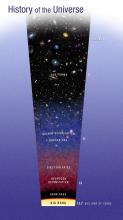Listen to today's episode of StarDate on the web the same day it airs in high-quality streaming audio without any extra ads or announcements. Choose a $8 one-month pass, or listen every day for a year for just $30.
You are here
Early Birth
Dark matter makes up about 85 percent of all the matter in the universe. So far, though, no one can tell us what it is. And a few studies suggest we can’t even be certain when it was created.
Dark matter doesn’t produce any detectable energy — hence the name. But we know it exists because it exerts a gravitational pull on the visible matter around it. It holds clusters of galaxies together. And it causes stars on the outer edges of galaxies to move faster than they would without the dark matter.
The leading idea says dark matter consists of subatomic particles. And it says the particles would have been forged in the Big Bang — the moment of creation for matter and energy, almost 14 billion years ago.
At the very beginning of that process, there was a period known as cosmic inflation. In a tiny fraction of a fraction of a fraction of a second, the universe puffed up faster than the speed of light. The “bang” came at the end of that period, as the first matter and energy took shape.
A few studies have said that dark matter could have been born during the period of inflation — before the birth of normal matter. And a study last year suggested the idea could be confirmed by studying how galaxies are spread across the sky. So looking at galaxies could tell us when dark matter was born. And it could even help scientists narrow down their searches for these elusive particles.
We’ll talk about the hunt for other particles tomorrow.
Script by Damond Benningfield



